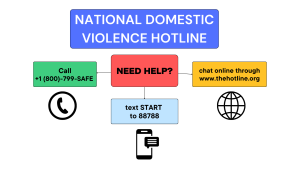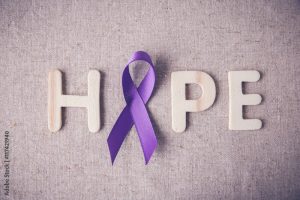11 The Power of Intervention: Key Strategies to End Domestic Violence
Sissy Ashley and Synclair McGovern
This chapter is based on the Social Ecological Model.
Domestic violence is a public health crisis that involves acts or threats of violence or abuse. Acts can include any behaviors considered threatening, controlling, or making family or children feel unsafe. The violence can include physical, verbal, or sexual behaviors between partners or family members (Krug, 2002). Family domestic violence effects can lead to negative health outcomes, including worsened mental and physical health, decreased quality of life, and decreased productivity (Huecker et al., 2023). Both children and families experience a decline in well-being. Victims experience an 11% increase in the number of doctor visits and a 4% decrease in employment (Bhuller et al., 2023).
Children and families who experience domestic violence face common health risks, including mental health conditions. Post-traumatic stress disorder (PTSD), depression, anxiety and substance abuse are at higher risk for these individuals(Doroudchi et al., 2023). PTSD often occurs because domestic violence typically involves repeated abuse over time, making it harder for the brain to process. Through multiple research findings, 51-75% of sheltered victims report PTSD symptoms (Nathanson et al., 2012). The rate of depression among abused women depression rate ranges from 35-70% in comparison to only 12% of women in the general population (Jonker et al, 2018). In order to cope with these feelings of depression and PTSD, domestic violence victims may turn to using and abusing substances. 13.5% of victims were alcohol-dependent in comparison with 1.4% of non-victims (Nathanson et al., 2012).
Although people typically associate domestic abuse with a decline in mental health, it also negatively affects physical health. Exposure to violence, stress, and even physical trauma for long periods of time can lead to a wide range of health problems later in life. Many victims report chronic pain(Wuest et al., 2010). In a 2013 study, domestically abused women reported a high amount of pain (35%) compared to the general population (18%) due to situational stress (Dillon et al., 2013). Victims suffer chronic stress, which can lead to heart problems, breathing issues, and muscle/bone disorders (Clemente-Teixeira et al., 2022).
Individual
Domestic violence solutions and interventions for individuals tend to target therapy and education for victims. The National Domestic Violence Hotline helps guide victims through the emotional effects of abuse and utilizes active listening in order to support and validate their feelings (National Domestic Violence Hotline, n.d.). Conversations can help with processing emotions and regaining confidence and self-love. This hotline is a confidential, 24/7 support service that connects individuals experiencing abuse with trained advocates. The phone-based organization provides immediate help through calling, texting, or chatting online through their website (National Domestic Violence Hotline, n.d.). Hotline staff provided emotional support to 95% of website visitors and 75% of callers (McDonnell et al., 2018). However, it goes much further than this initial contact. They actively connect victims with local resources such as therapy services, counselors, doctors, and support groups, providing personalized support at the individual level. The National Domestic Violence Hotline provided effective crisis intervention to over 60% of visitors and 65% of callers (McDonnell et al., 2018). In order to get in contact with this program, individuals can use many different methods, as explained in the image below. Access the hotline here

Relationship
For children and families experiencing domestic violence or abuse, they need a support system (i.e., family, friends, and mentors) to feel equipped to handle these situations. Thrive, an initiative led by North Valley Community Foundation, focuses on emotional healing for children and families (North Valley Community Foundation, n.d.). Their specific focus, the Children’s Resilience Initiative, is an online series that provides the community around these individuals with the tools and education needed to create a supportive environment. Studies show that education targeted toward victims’ surrounding communities significantly improves awareness, knowledge of resources, and confidence in their ability to help (Bird et al., 2024). Thrive provides a series of videos that target parents, educators, and other members of the community, allowing them to better understand the impact and stress that accompany these adverse experiences (North Valley Community Foundation, n.d.). Along with a video course, discussion guides provide information that promotes a more intentional process and deeper discussion. More information can be found on their website.
Community
When looking at health in relation to domestic violence, the impacts are felt by those experiencing, witnessing, or those who have experienced domestic violence.
In South Carolina, there are multiple resources available to those affected. Safe Harbor is a South Carolina-based program that offers a large number of services for those who are experiencing or may have experienced domestic violence. Emergency and transitional housing are available with a support team included to help them get back on their feet. (Safe Harbor, n.d.). Safe Harbor arranges each survivor with a safe community, a positive team, and the mindset necessary to achieve their goals (Safe Harbor, n.d.). Safe Harbor aims to help families bounce back and be resilient.
Victims can find virtual support groups and resources through various online organizations. Speak Your Truth is a private Facebook group that creates an avenue for its members to bring awareness, as well as share words of encouragement. In addition, Domesticshelter.org (n.d.) brings awareness through education while providing community support.
The Model Policy is a workplace program that aims to promote safe measures and help those who are dealing with domestic violence (Cornell Law School, 2020). This program includes training on educating others about domestic violence, how to respond effectively, how to create a safe and welcoming work environment, how to assist those affected by domestic violence, and lastly, how to ensure that the employee can access disciplinary actions against their offender (Cornell Law School, 2020). The Model Policy is flexible enough that the employer, based on their own workplace, can tweak or alter it.
Societal
Society must utilize rules, laws, and guidelines to end this cycle. Policies have been seen to improve domestic violence if tailored to the needs of the survivor (Dusenbery & Nembhard, 2024).
Law enforcement and legal team members should recognize the need for policies to address domestic violence. (Dusenbery & Nembhard, 2024). The United States Department of Justice (DOJ) and Office on Violence Against Women (OVW) provide resources to attorneys, judges, law enforcement, and other legal team members to best work at properly addressing domestic violence. The DOJ and OVW provide guidelines to prevent bias when responding to domestic violence (OVW, 2025). Researchers have proven that equal access and respect benefit these survivors (Dusenbery & Nembhard, 2024). The DOJ and OVW also aim to treat victims with humanity, strengthen the federal response, and provide protocols for medical examinations relating to domestic violence (Office on Violence Against Women, 2025).

Key Takeaways
- Domestic violence is a public health crisis that involves abusive behaviors that harm victims’ safety and overall health.
- Victims often suffer from mental illnesses like PTSD and depression, as well as chronic physical health issues.
- The National Domestic Violence Hotline provides confidential, 24/7 support and connects victims with more resources.
- Community partners like Thrive equip parents, educators, and peers to help children and families heal through education and community support.
- Programs like Safe Harbor and online support groups offer housing, counseling, and safe spaces to help survivors rebuild their lives.
- Government agencies and workplace policies aim to reduce domestic violence through legal protections, emphasis on education, and ethical practices.
References
Bhuller, M., Dahl, G. B., Løken, K. V., & Mogstad, M. (2023). Domestic violence reports and the mental health and well-being of victims and their children. Journal of Human Resources, 59(S), S152–S186. https://doi.org/10.3368/jhr.1222-12698R1
Bird, K. S., Stokes, N., Rivas, C., Tomlinson, M., Delve, M., Gordon, L., Gregory, A., Lawrence, K., & O’Reilly, N. (2024). Training informal supporters to improve responses to victim-survivors of domestic violence and abuse: A systematic review. Trauma, Violence & Abuse, 25(2), 1568–1584. https://doi.org/10.1177/15248380231189191
Clemente-Teixeira, M., Magalhães, T., Barrocas, J., Dinis-Oliveira, R. J., & Taveira-Gomes, T. (2022). Health outcomes in women victims of intimate partner violence: A 20-year real-world study. International Journal of Environmental Research and Public Health, 19(24), 17035. https://doi.org/10.3390/ijerph192417035
Cornell Law School. (2020, November 23). Domestic violence and the workplace model policy and toolkit. https://www.lawschool.cornell.edu/academics/experiential-learning/clinical-program/gender-justice-clinic/domestic-violence-and-the-workplace-model-policy-and-toolkit/
Dillon, G., Hussain, R., Loxton, D., & Rahman, S. (2013). Mental and physical health and intimate partner violence against women: A review of the literature. International Journal of Family Medicine, 2013, 313909. https://doi.org/10.1155/2013/313909
DomesticShelters.org. (n.d.). Domestic violence online support. https://www.domesticshelters.org/resources/online-forums-and-chats
Doroudchi, A., Zarenezhad, M., Hosseininezhad, H., Malekpour, A., Ehsaei, Z., Kaboodkhani, R., & Valiei, M. (2023). Psychological complications of the children exposed to domestic violence: A systematic review. Egyptian Journal of Forensic Sciences, 13(1), 26. https://doi.org/10.1186/s41935-023-00343-4
Dusenbery, M., & Nembhard, S. (2024, October 25). Nine ways policymakers can improve domestic violence response. Urban Institute. https://www.urban.org/urban-wire/nine-ways-policymakers-can-improve-domestic-violence-response
Huecker, M. R., King, K. C., Jordan, G. A., & Smock, W. (2023). Domestic violence. StatPearls. https://www.ncbi.nlm.nih.gov/books/NBK499891/
Jonker, I. E., M Lako, D. A., Beijersbergen, M. D., Sijbrandij, M., & M Wolf, R. L. (2018). Factors Related To Depression and Post-Traumatic Stress Disorder in Shelter-Based Abused Women. Violence Against Women, 25(4), 401. https://doi.org/10.1177/1077801218790700
Krug, E. G. (2002). World report on violence and health. World Health Organization. https://www.who.int/publications/i/item/9241545615
McDonnell, K. A., Nagaraj, N. C., Mead, K. H., Bingenheimer, J. B., Stevens, H., Gianattasio, K. Z., & Wood, S. R. (2018). An evaluation of the national domestic violence hotline and loveisrespect: A report from the accomplishments of the domestic violence hotline, online connections, and text project. U.S. Department of Health and Human Services, Administration for Children & Families. https://acf.gov/sites/default/files/documents/opre/advhocat_frd_report_to_opre_111918_508_compliant.pdf
Nathanson, A. M., Shorey, R. C., Tirone, V., & Rhatigan, D. L. (2012). The prevalence of mental health disorders in a community sample of female victims of intimate partner violence. Partner Abuse, 3(1), 59–75. https://doi.org/10.1891/1946-6560.3.1.59
National Domestic Violence Hotline. (n.d.). Domestic violence support. http://www.thehotline.org
North Valley Community Foundation. (n.d.). Thrive Children’s Resilience Initiative. https://www.nvcf.org/thrivecri
Office on Violence Against Women. (2025, January 22). Domestic violence. U.S. Department of Justice. https://www.justice.gov/ovw/domestic-violence
Safe Harbor. (n.d.). A safe place to start a new life. https://www.safeharborsc.org/
Wuest, J., Ford-Gilboe, M., Merritt-Gray, M., Wilk, P., Campbell, J. C., Lent, B., Varcoe, C., & Smye, V. (2010). Pathways of chronic pain in survivors of intimate partner violence. Journal of Women’s Health, 19(9), 1665–1674. https://doi.org/10.1089/jwh.2009.1856
Something relating to the home, family or household
A mental health condition that occurs after witnessing or experiencing a traumatic event
A mood disorder that is marked by varying degrees of sadness, despair, and loneliness and that is typically accompanied by inactivity, guilt, loss of concentration, social withdrawal, sleep disturbances, and sometimes suicidal tendencies
An abnormal and overwhelming sense of apprehension and fear often marked by physical signs (such as tension, sweating, and increased pulse rate), by doubt concerning the reality and nature of the threat, and by self-doubt about one's capacity to cope with it

